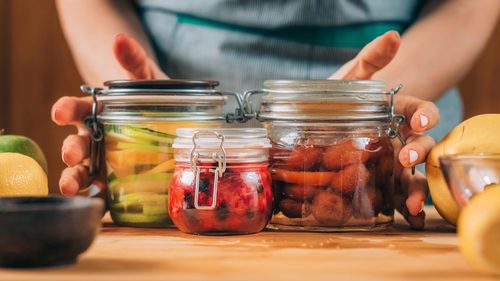If you’re tired of throwing out wilted and mushy fruits and veg, we’ve got a game-changing storage hack that will keep them fresh for longer. The secret? Glass jars and water.
Here’s how it works
Chop up your fruits and veggies into bite-sized pieces and place them in glass jars. Then, cover them with water and seal the jars with airtight lids. The water creates a barrier that keeps oxygen out, which slows down the ripening process and prevents spoilage.
This hack works especially well for produce that tends to go bad quickly, like berries, leafy greens, and herbs. You can also use it for harder veggies like carrots and celery. Just make sure to change the water every few days to keep things fresh.

Getty
Why does it work?
Well, when fruits and veggies are exposed to oxygen, they release a gas called ethylene. This gas speeds up the ripening process and can cause produce to spoil faster. By covering your produce with water, you create an anaerobic environment that slows down the release of ethylene and keeps your fruits and veggies fresh for longer.
And the best part? This hack is not only effective but also environmentally friendly. By using glass jars instead of plastic bags, you’re reducing your plastic waste and doing your part to help the planet.
Other nifty fridge storage hacks to have in your back pocket
But wait, there’s more! Here are a few other nifty storage hacks to keep things fresh in the fridge for longer:
- Store fresh herbs in a jar with a damp paper towel: This will keep them hydrated and prevent them from wilting.
- Wrap lettuce in a dry paper towel: This will absorb excess moisture and prevent your lettuce from getting slimy.
- Keep onions and garlic in a cool, dark place: This will prevent them from sprouting and going bad too quickly.
- Store mushrooms in a paper bag: This will allow them to breathe and prevent them from getting slimy.
By using these simple storage hacks, you can keep your fruits and veggies fresher for longer and reduce your food waste. Give them a try and see for yourself!
ALSO SEE:
Feature Image: Getty

